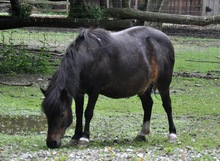In a recent article on horse health, SmartPak asks the following question of horse owners: Equine Metabolic Syndrome VS Cushing's/Pituitary Pars Intermedia Dysfunction - Do you know the difference? Then SmartPak offers some valuable information for horse owners.

Shetland pony with symptoms of equine metabolic syndrome
SmartPak offers important information to horse owners about differences between Equine Metabolic Syndrome and Cushing's disease also known as Pituitary Para Intermedia Dysfunction.
© 2015 by DFoidl
EMS refers to a collection of endocrine and metabolic abnormalities associated with obesity and the development of laminitis in horses. Faulty insulin metabolism is a key component of EMS and can include both insulin resistance (IR) and hyperinsulinemia. (Insulin is a vital hormone that transfers glucose from the bloodstream into tissues). IR is the failure of tissues to respond appropriately to insulin, while hyperinsulinemia means elevated levels of insulin in the blood.
Equine metabolic syndrome
- Middle-aged
- EMS is first commonly noticed in horses approximately 8â18 years of age
- Abnormal fatty deposits
- Horses with EMS may have a cresty neck as well as abnormal âregionalâ fat pads behind the shoulders, over the tail head, and above the eyes
- Breed link: More common in âeasy keeperâ types such as pony breeds, Morgans, gaited horses, Arabians, and warmbloods, EMS is likely to be an inherited trait
- Cresty neck
Cushingâs/pituitary pars intermedia dysfunction (PPID)
PPID refers to a collection of clinical signs due to overproduction of certain pituitary hormones. It is caused by an enlarged and overactive pituitary gland normally kept in check by inhibitory dopamine from the hypothalamus. In addition to obvious changes in hair coat, signs may also include weight/muscle loss, behavioral changes, increased infections, and laminitis.
- Loss of topline
- Loss of muscle
- Muscle wasting is common in horses with this condition and may be seen as loss of topline and a rounded abdomen (caused by decreased abdominal muscling)
- Hypertrichosis
- 50% of PPID horses may be affected by a long, curly hair coat that fails to shed
- Older age
- Clinical signs are most frequently first seen in horses in their mid-teens
Next step:
- If youâre concerned that your horse may have one of these conditions, your first step is to talk to your veterinarian.
- In addition to looking at the physical appearance of your horse, there are a few different diagnostic tests your vet may perform:
- Tests to diagnose EMS may include fasting insulin concentration and/or the oral sugar test
- Tests to diagnose PPID may include the TRH stimulation test and/or resting ACTH measurement
3. Once your vet makes a diagnosis, work together to design a treatment, dietary, and management plan for your horseâs individual needs.
SmartPak has a number of supplements and medications that may help horses with the above conditions.
About SmartPak
From the feed room to the tack room, SmartPak offers innovative solutions to help riders take great care of their horses. SmartPak was founded in 1999 with the introduction of the patented SmartPak supplement feeding system. The revolutionary, daily dose SmartPaks are custom-made for your horse, individually labeled and sealed for freshness. With the success of this simple and convenient feeding system, SmartPak has continued to expand its offering of quality products, including its own line of more than 55 supplement formulas called SmartSupplements, and a wide variety of tack, equipment, and supplies.
The company has grown rapidly each year and is now the largest retailer of equestrian products in the United States. SmartPakâs success has been powered by a passion for delivering an unbeatable customer experience, and the company has been recognized with a Bizrate Circle of Excellence award as well as an âEliteâ rating from STELLAService. A nine-time Inc. 500/5000 honoree, SmartPak is the only equine company ever named to the Inc. 500 list.
